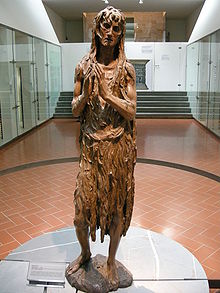Mary Magdalene (Donatello)
The Mary Magdalene , in the literature Penitent Mary Magdalene , is a sculpture in Florence . It was created by Donatello in the middle of the 15th century and is considered one of the “strongest, at least one of the most disconcerting” works of Donatello because of the realism of the depiction.
Client and method of creation
The somewhat less than life-size figure was commissioned by the Medici from 1453 to 1455. At that time Donatello was well over sixty years old and had returned from his stay in Padua . He had almost been forgotten in Florence and kept himself alive more badly than well with small commissioned works.
The figure of the penitent Mary Magdalene is shown , a motif that goes back to the Legenda aurea of Jacobus de Voragine , known in the Middle Ages . Accordingly, the witness for the resurrection of Christ (cf. John 20, 1–18) withdrew into the wilderness and atone there. Donatello shows the figure already marked by death.
Donatello made the figure from a block of the trunk of a silver poplar . He first worked out the basic structure roughly with a gouge and then modeled the details with plaster of paris . He then painted the figure in many colors, originally using plenty of gold leaf . In the 18th and 19th centuries, the figure was completely painted over several times, albeit in one color, and the original version was almost completely lost. It was not until the restorations in the 1960s that what was left of Donatello's original work was brought back to life.
Whereabouts
After completion, the figure was in a niche on the southwest side of the Baptistery of San Giovanni , which belongs to the Florentine Cathedral of Santa Maria del Fiore , but it is not known whether it was actually created for this location. When the Arno flooded the century on November 4, 1966 - on this day more than two thirds of the city center of Florence was flooded and there was severe damage to almost all historical buildings - the figure was also damaged. She stood up to her legs in mud and water. After the salvage and restoration with the production of the original version, it was initially set up temporarily and then finally in its own room in the Museo dell'Opera del Duomo .
Representation
The figure depicted the penitent extremely realistically close to death, which is also considered to be due to Donatello's human change from a humanist to a pessimist . She stands on her left leg in a slight contraposto , the right one slightly bent. The arms are raised in a prayer position . Maria Magdalena is dressed with a very detailed shaggy fur, the hair runs down to the upper arms and in a strand down to the legs. The face has sunken, the patchy teeth and the deep-set eye sockets make the penitent appear emaciated. The figure gets the real tension from the contrast between the approaching death and the former beauty of this person, of which the high cheekbones of the face and the long hair, which is considered to be sensual, are still hints. The theme of the figure is ultimately the dissolution of all material and corporeal being in resistance and in rebellion against death through repentance and the worship of Christ. Even if only remnants of the original gilding are preserved today, it was precisely this that gave the figure its original attraction in the baptistery, which is only lit by candles.
Baldini comments on the figure: “He (meaning Donatello, author's note) no longer shows the person who determines the course of things, but the person who reaches his very own limit: death. It is surely this ability to illustrate the struggle between life - in the remaining beauty - and death - in the decay of the body - in a figure that makes this work so great ”.
It is reported that after its completion, the figure had "like a clap of thunder" to contemporary Florentine artists because of its shocking realism.
Individual evidence
- ↑ a b c Grote, Florence - Shape and History of a Community , p. 195
- ^ Braunfels, Small Italian Art History , p. 233
- ↑ a b c d Tomann, The Art of the Italian Renaissance - Architecture, Sculpture, Painting, Drawing , p. 196
- ↑ a b c d Baldini, Cathedral and Baptistery in Florence , p. 34
- ↑ Baldini, Duomo and Baptistery in Florence , p. 5
- ↑ Grote, Florenz - Shape and History of a Community , p. 194
- ↑ Baldini, Duomo and Baptistery in Florence , p. 6
- ↑ Baldini, Duomo and Baptistery in Florence , p. 7
- ↑ Emphasis also in the original quote
literature
- Umberto Baldini: Cathedral and Baptistery in Florence , Manfred Pawlak Verlagsgesellschaft, Herrsching 1989. ISBN 3-88199-607-9
- Wolfgang Braunfels : Little Italian Art History , DuMont Buchverlag, Cologne 1984. ISBN 3-7701-1509-0
- Andreas Grote: Florenz - Gestalt und Geschichte einer Gemeinwesens , 5th edition, Prestel Verlag, Munich 1980. ISBN 3-7913-0511-5
- Loretta Santini: Florence, The Cradle of Italian Art , Nova Lux, Giusti di Becocci, Florence 1973
- Rolf Toman (Ed.): The art of the Italian Renaissance - architecture, sculpture, painting, drawing , Tandem Verlag, Cologne 2007. ISBN 978-3-8331-4582-7

